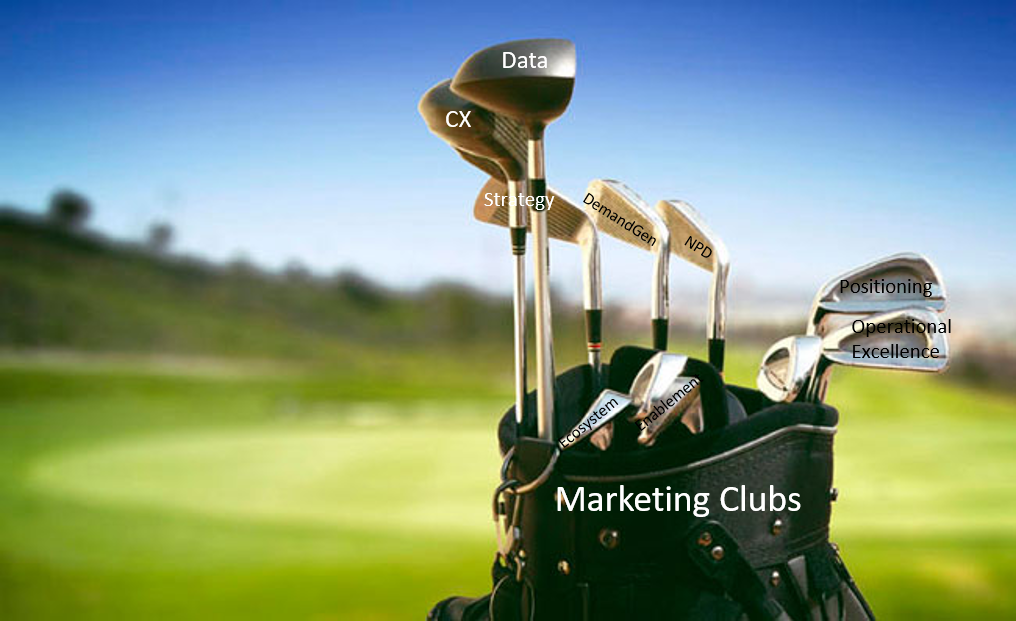
Marketing performance excellence takes building skills to succeed at both the long and short game.
Marketing Performance Excellence Takes Proficiency at Both the Long and Short Game
Golf. Not my game but I’ve learned a lot about it over the past 30 years. I’ve been exposed to the game of golf at least weekly as my husband enjoys both heading out to chase the white ball and watching the tournaments on tv. It’s an interesting game because you are playing both against the course and the competition. I’ve learned many factors affect the game. Things the golfer can’t control, such as weather and the type of grass on the course, and things they can control, like how well they can read the green and their ability to use the clubs to play both the long game and the short game. I remember hearing Jimmy Walker in his post-game interview after he won the PGA championship expressing how important it is to be proficient with every club in the bag. This concept of proficiency struck me as being particularly relevant to organizations striving for Marketing performance excellence.
Marketers who work in an organization where the CEO expects the Marketing function to drive revenue and growth, own the customer experience, and bring data-based insights to the table to outsmart the competition, need to be proficient with all the Marketing “clubs in the bag” and be able to excel at both the long game and the short game.
What does it mean to be proficient? Proficiency means to be thoroughly competent. Not merely competent, that would be capable. There is a nuance to proficient in that it suggests skillful expertise. The amount of time it takes to reach an expert level of proficiency depends on several factors.
One of these factors affecting Marketing performance excellence is how quickly you can come up with the learning curve. The length of your learning curve plays a key role in determining how fast you’ll be successful when you embark on acquiring a new skill. With the surge in data, the proliferation of channels, and customers taking more control of the buying process, marketers are faced with needing to work daily to keep their game sharp. It was only a short time ago marketers were learning about digital marketing. Now it is a fundamental skill – a standard club in the bag. The focus on customer insights and performance management is forcing marketers to come up with the learning curve on data, analytics, and metrics, as these too are becoming standard clubs in the bag.
Marketing Performance Takes these 12 Marketing Clubs
On several levels, golf provides a wonderful metaphor for marketers. Each course is unique and has a slope and course rating (degree of difficulty) that offers a variety of challenges from teeing off to putting in. Even if you play the same course, the play is seldom the same because the hole is deliberately and regularly changed on each green. Wind, something beyond a player’s control, also plays a role. As marketers, every customer journey and market is unique. The customer journey is subject to change and there are aspects of each journey beyond your control.

Profiency with all the clubs in the bag is the key to Marketing performance excellence
Golf, like marketing, is a game of effectiveness. A game of how well and accurately you hit the ball. It is also a game of efficiency. Each golfer has the same opportunity at the start of each game with the key objective to reach each “hole” in as few strokes as possible. Golfers use different clubs depending on their skills, the course, the conditions (such as the type of grass), distance to hit (driving versus putting), and type of ball strike. This is what Jimmy meant by being proficient with all the clubs in the bag. Being able to skillfully and expertly select and use each club at the right time for the right purpose.
If you’re only competing in Putt-Putt golf, then, by all means, stick to your putter and hone your putting skills. For marketers who want to move beyond this type of play, they must be able to follow Jimmy’s advice and be proficient with every club. The standard golf bag includes 12 clubs: 3 woods, 8 irons, and 1 putter.
What clubs do Marketers need in their bag? To play the long game and short game, there are 12 clubs that every high-performance Marketing team should know when and how to use well.
Every Marketing organization should be able to adeptly apply these clubs based on whether you are driving for new customers or working to grow business with existing customers. It takes time and the right resources to become proficient in using all of these Marketing clubs.

Take steps to shorten your learning curve.
Shorten Your Learning Curve
Consider these three techniques used by successful people to come up your learning curve faster and facilitate Marketing performance excellence.







